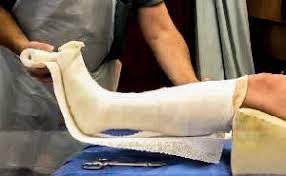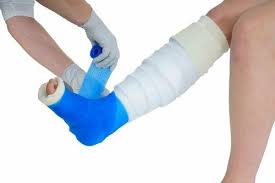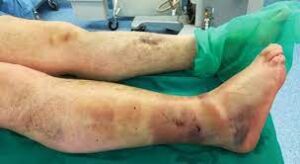Cast Care Tips 101: Types, Placement, Precautions, Complications, Do’s and Don’ts
Casts, or orthopedic casts, are support structures used to immobilize broken or fractured bones. They are made from a strong, lightweight material such as plaster or fiberglass and can help keep bones in place while they heal. Casts come in a variety of shapes and sizes, depending on the area of the body being treated. They are devices used to support an injured bone in place while it heals, generally applied by a doctor or healthcare professional and require regular check-ups to ensure the integrity of the cast and proper healing of the bone. Casts help provide support to an injured area, reduce pain and swelling, maintain joint alignment, promote healing of soft tissue injuries, and reduce any risk of further damage to the affected area. Additionally, they protect against external trauma while allowing for some freedom of movement by providing flexibility around certain joints. Please keep reading for details on the following topics:
Functions of a cast
Types of casts
Factors that determine the type of cast used
Back slab
Fiberglass or synthetic casts
How a cast is placed
Precautions when in a cast
Complications of casts
When to seek urgent medical care

Functions of a cast
To keep a broken bone in place
To treat a broken or fractured bone
To immobilize a limb after a surgery involving the bones, joints or tendons
To protect an area from further injury by restricting movement
Immobilize a body part in a specific position
Correct or prevent deformities
Stabilize and support unstable joints.
Factors that determine the type of cast used
Types of casts

There are several types of casts used in medical settings:
Back slab: is a temporary type of cast that provides support and stability to an injured limb, typically used immediately after an injury to prevent swelling. It covers only part of the circumference of the limb and is made from plaster of Paris or fiberglass. Back slabs are lightweight, breathable, and easy to apply, making them ideal for providing initial support and comfort during the early stages of injury management. They are usually worn for a short period, often until swelling subsides or until a more permanent cast can be applied.
Plaster of Paris: is a commonly used material in orthopedic casting for its molding properties and strength. It consists of gypsum powder mixed with water to form a paste that can be easily molded around an injured limb. Plaster of Paris casts are typically used for fresh fractures due to their ability to conform closely to the shape of the limb, providing excellent support and immobilization. However, they can take several days to fully harden and are heavier compared to fiberglass casts. Additionally, it’s important to keep plaster casts dry, as exposure to moisture can weaken the material and compromise its effectiveness in supporting the injury.
Synthetic Cast (Hard and Soft Cast): are available in hard and soft varieties, are alternatives to traditional plaster of Paris casts.
- Hard Casts: These casts provide rigid support and immobilization, typically made from fiberglass or other synthetic materials. They offer superior strength and durability compared to plaster casts and are less likely to break down when exposed to moisture. Hard casts are commonly used for stabilizing fractures and injuries that require firm immobilization.
- Soft Casts: Soft casts offer flexibility and comfort while still providing support and protection. They are made from a softer, more pliable material, such as padded foam or fabric, which allows for some degree of movement. Soft casts are often used for injuries that require gentle support or for patients who may experience discomfort with a rigid cast. Both hard and soft synthetic casts are lightweight, breathable, and available in various colors and designs. They are also more waterproof than plaster casts, making them suitable for activities involving water. However, it’s important to ensure proper care and maintenance to prevent skin irritation and ensure the cast remains effective in supporting the injury.

How a cast is placed

Applying a cast involves several steps to ensure proper immobilization and support for the injured limb. Here’s an overview of how a cast is typically placed:
- Preparation: Before applying the cast, the healthcare provider will review the patient’s medical history and assess the extent of the injury. They may also take X-rays to confirm the diagnosis and ensure proper alignment of the bones.
- Preparation of the Limb: The affected limb is exposed, and any jewelry is removed to prevent interference with the casting process. Any wounds or open injuries are cleaned and treated to minimize the risk of infection.
- Reduction of Dislocations: If the limb is dislocated, the doctor will perform a reduction procedure to realign the bones before applying the cast.
- Positioning: The patient is positioned comfortably, either sitting or lying down, depending on the location of the injury. For example, a patient with a broken arm may sit with their elbow resting on a table, while a patient with a broken leg may lie on their back with the leg elevated.
- Cleaning and Padding: The injured limb is carefully cleaned to remove any dirt or debris, and any open wounds are treated to prevent infection. Next, a layer of soft padding, such as cotton or padding material, is applied to protect the skin and provide additional comfort.
- Application of Casting Material: The casting material, typically plaster of Paris or fiberglass, is prepared according to the manufacturer’s instructions. It is then dipped into water and rolled onto the padded area of the limb in layers. The healthcare provider molds and shapes the wet casting material to conform to the contours of the limb, ensuring proper alignment and immobilization.
- Setting and Hardening: Once the casting material is applied, it begins to harden and set within a few minutes. The healthcare provider carefully monitors the process to ensure the cast hardens evenly and maintains proper alignment.
- Final Checks: After the cast has fully hardened, the healthcare provider may perform additional checks to ensure it is secure and comfortable. They may also trim any rough edges and provide instructions on how to care for the cast and when to follow up for further evaluation.
- Post-Casting Care: The patient is educated on proper cast care, including keeping the cast dry, avoiding putting weight on the cast, and watching for signs of complications such as increased pain or swelling.
- Post-Casting X-ray: After the cast has hardened, another X-ray may be taken to confirm proper alignment and placement of the bones within the cast.
Precautions when in a cast

When wearing a cast, it’s essential to take precautions to ensure proper healing and avoid complications. Here are some precautions to follow:
- Keep the Cast Dry: Avoid getting the cast wet, as moisture can weaken it and cause skin irritation. Use a waterproof cover or plastic bag to protect the cast while showering or bathing.
- Elevate the Limb: Elevate the injured limb above heart level whenever possible, especially during the first 72 hours after cast placement. This helps reduce swelling and promote circulation.
- Avoid Putting Weight on the Cast: Do not lean or put weight on the cast, as this can cause it to break or become misaligned. Use crutches or a walker if necessary to avoid putting weight on the injured limb.
- Do Not Insert Objects Inside the Cast: Avoid inserting objects such as sticks or pencils inside the cast to scratch the skin, as this can cause injury or infection. Use a hairdryer on a cool setting to alleviate itching if needed.
- Do Not Trim or Modify the Cast: Do not attempt to trim or modify the cast yourself, as this can compromise its integrity and effectiveness. If the cast feels too tight or uncomfortable, contact your healthcare provider for evaluation.
- Monitor for Signs of Complications: Watch for signs of complications such as increased pain, swelling, numbness, tingling, or discoloration of the skin around the cast. Seek medical attention if you experience any of these symptoms.
- Follow Rehabilitation Guidelines: Once the cast is removed, follow any rehabilitation or physical therapy guidelines provided by your healthcare provider to regain strength and mobility in the injured limb.
- Exercise Fingers and Toes: Wiggle your fingers (if the cast is on your arm) or toes (if the cast is on your leg) regularly to improve blood circulation and prevent stiffness. This can help reduce the risk of complications such as muscle atrophy and joint stiffness.
-
Avoid Swimming: Refrain from swimming or submerging the cast in water, as moisture can weaken the material and lead to skin irritation or infection. Use waterproof covers or plastic bags to protect the cast while bathing or showering.
Complications of casts

Complications associated with casts can include:
- Compartment Syndrome: a medical condition that occurs when too much pressure builds up within the muscles of a particular area of the body. This pressure, if left untreated, can cause tissue damage, nerve damage, and even limb loss. Compartment syndrome is most commonly seen in the lower legs and arms, though it can occur in any part of the body. It is caused by a combination of factors, including trauma, swelling, and tight casts or bandages, although medical conditions such as diabetes, kidney failure, and burns can also increase the risk of developing compartment syndrome. Treatment of compartment syndrome typically involves surgery to reduce the pressure, followed by physical and occupational therapy to restore function.
- Skin Issues: Skin irritation, pressure sores, or allergic reactions may develop due to prolonged contact with the cast material.
- Muscle Atrophy: Immobilization under a cast can cause muscle weakness and wasting, known as muscle atrophy.
- Joint Stiffness: Lack of movement can lead to stiffness in nearby joints, reducing flexibility and range of motion.
- Itching and Discomfort: The skin under the cast may become itchy or irritated, leading to discomfort and difficulty sleeping.
- Cast Syndrome: Compression of the blood vessels and intestines due to tightness of the cast around the abdomen, which can cause abdominal pain and other gastrointestinal symptoms.
- Infection: Moisture accumulation under the cast can create a favorable environment for bacterial growth, increasing the risk of skin infections.
- Pressure Sores: Prolonged pressure on certain areas of the skin may cause pressure ulcers, especially in individuals with limited mobility.
- Skin Maceration: Softening and breakdown of the skin due to prolonged exposure to moisture from sweating or inadequate drying after exposure to water.
- Neurovascular Compromise: Nerve or blood vessel compression due to tight casting can result in sensory disturbances, numbness, or impaired circulation.
When to seek urgent medical care
It is important to know when to seek urgent medical care, as delaying appropriate treatment can lead to further health complications. If you experience any of the following symptoms, you should seek medical help immediately. If you have any doubts about whether you should seek medical care, it is always better to err on the side of caution and consult with your doctor. Seek urgent medical care if you experience any of the following symptoms while wearing a cast:
- Increased pain and tightness in the limb enclosed by the cast.
- Numbness or tingling sensation in the limb.
- Burning or stinging sensation under the cast.
- Swelling or blistering on the skin underneath the cast.
- Inability to move the fingers or toes of the limb.
- Discoloration or coldness of the fingers or toes.
- Feeling that the cast is too tight or too loose.
- Red or raw skin around the edges of the cast.
- Cracks or soft spots in the cast material.
- Drainage of fluid or foul odor from the cast.
- Fever or other signs of infection.
Disclaimer: The information provided in this content is for general informational purposes only. It is not intended as medical or healthcare advice, diagnosis, or treatment. Always seek the advice of a qualified healthcare professional with any questions you may have regarding a medical condition or healthcare decisions.

